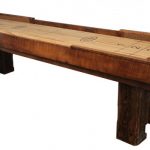
Curling: Table Shuffleboard’s Distant Cousin
Canadians are known for being masters of winter sports. Aside from dominance in hockey – a sport that is as popular there as football is stateside – the Great White North is known for a host of other activities that take place on an ice rink. Curling, for example, is one sport that Canadians tend to be masters at, having taken home more Olympic Gold Medals for it than any other nation at the Winter Games.
Curling and shuffleboard have a lot in common as they both involve lagging a heavy weight down a long lane, aiming for the farthest foul zone. In curling, the weight is called a rock, as it is literally a heavily polished piece of granite, and the game is played with two teams of four.
Each team has eight stones, and points are accumulated by getting the stones closest to the center of the main target zone, which is known as the house. Unlike table shuffleboard, curling requires that all of the players help each stone get to the house rather than taking turns lagging rocks on their own. This is where the image that most people associate with curling comes into play, as players skate down the ice with a regulation broom, clearing a path for the stone to glide into the house smoothly.
The game was invented in Scotland, where highlanders would practice curling on the frozen glens that dot the region all the way back to the 1500s. It became popular throughout northern climates in Europe and eventually North America where there where frozen waters thick enough to support the massive rocks and a crowd of spectators. It is essentially considered the cold-weather equivalent to floor shuffleboard, although variations of the game on shuffleboard tables have been popular in bars throughout Canada.



